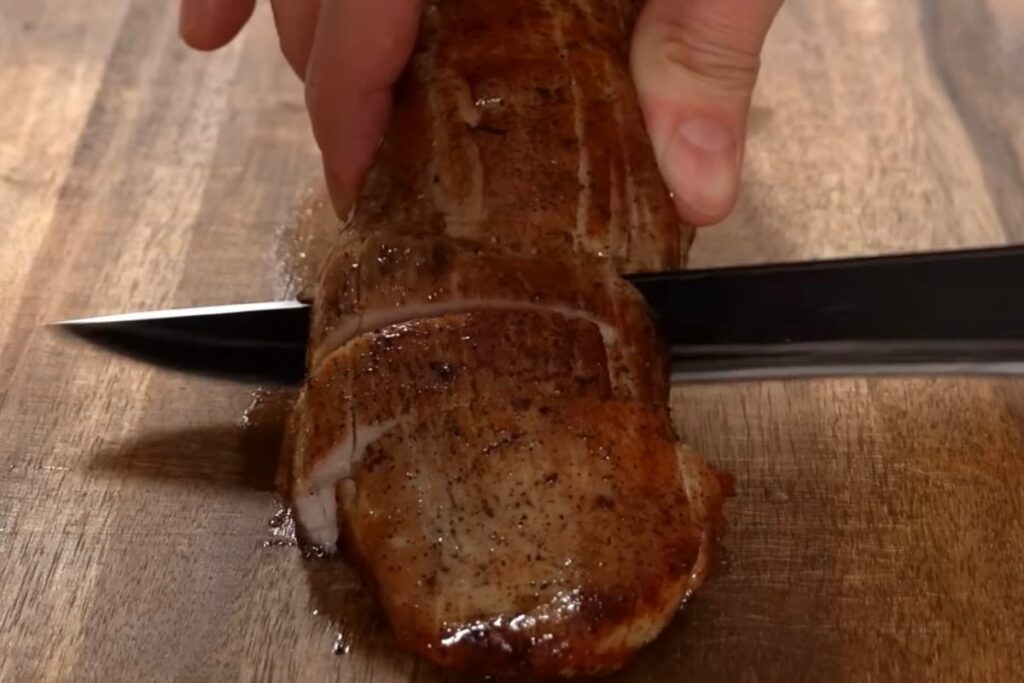If you’re cooking pork, you might well eb worried that you;re going to get something wrong. Undercooking and overcooking are both things that can happen, especially if you’re new to cooking. And if you’ve splashed out on an expensive cut like pork tenderloin, you really don’t want to get it wrong!
For instance, if you’re not sure what color your pork should be when it’s fully cooked, you might be confused if you see that it’s still pink inside – even after you’ve cooked it for exactly as long as you think you’re meant to!
Well, there’s no need to worry, or be unsure any longer – as this article will show you all you need to know about making sure that your pork tenderloin is cooked to perfection, tasty and safe to eat – whether it still has that pink hue or not!

What Is Pork Tenderloin?
Pork tenderloin is a cut of pork – no surprises there! It’s a long, thin cut of pork, cut from a muscle that lies along the central spine portion of the pig. This is called the psoas major muscle, and it’s the most tender part of the pig – hence the name “tenderloin”!
The psoas major isn’t used for the heavy duty task of moving the pig about, but is instead used for posture – making it more tender, because it doesn’t have to do so much heavy work.
If you buy some pork tenderloin from the butcher, you might notice that there’s a skin-like membrane attached to it, with a silvery hue, This is called the silverskin – it’s a normal part of the cut, but one that you’ll remove before cooking – if you don’t want to do that yourself, then ask the butcher to cut it off for you.
It’s a very lean cut of pork – meaning there’s not a lot of fat on it compared to other pork cuts. It’s completely boneless too. These factors make it a very easy cut to cook – and there are a lot of ways that you can cook it too!
You can grill them, roast them, broil them – the choice is yours. That’s one of the many reasons that pork tenderloin is such a popular and versatile cut of pork.
It’s a delicious and popular cut, and has a place in so many dishes! As it’s quite a lean cut, it can also be very easy to overcook it – and you certainly don’t want to do that, because this is probably the most expensive cut of pork.
Still, learn to cook well with it, and you’ll find that pork tenderloin is a delicious cut of meat that you can put to great use in a huge variety of different meals.
My Pork Is Pink In The Middle – Is It Safe?
It can be easy to think that meat should be cooked until it’s a uniform color throughout, but in reality there’s a little more to good – and safe – cooking than just that. Looking at the color helps, of course – but there are more clues, and more things to consider.
Your pork tenderloin can actually be pink at the center, and still be safe to eat. Or, it can be pink inside, and completely unsafe to eat! Normally, cooked pork will have a white, but still slightly pinkish hue. And indeed, this coloration is usually a great indicator of a cut of pork that’s been cooked to perfection.
However, if you’re unsure – for instance, if you’re new to cooking pork, and don’t want to make a mistake – there is a far better way of telling if your pork tenderloin is cooked than simply looking at it.
And, frankly, with a cut as delicious and expensive as pork tenderloin, you don’t really want to be cutting into it to check whether it’s cooked – you’re only going to ruin it! You’ll let the juices flow out of it, leaving it dry – which, of course, you don’t want!
Whatever cut of meat you’re cooking, you’ll have to get it to reach a certain temperature at the center before it can be considered cooked, and therefore safe to eat. If your pork doesn’t reach this temperature, then, very simply put – keep cooking your tenderloin until it does!

There’s only one way to be 100% sure that your meat has reached the crucial temperature for safe eating. Get a good quality meat thermometer, and use it. It’s the only way to ensure that you’re cooking your meat properly.
Without one, you’re just guessing – and when it comes to something as important as food hygiene, you could be literally taking your life in your hands!
If you take a meat thermometer, and stick it into your pork tenderloin, you’ll instantly know the internal temperature of the cut. You need to get your pork up to 145 degrees Fahrenheit. Any lower – even a single degree – and you can’t consider it safe to eat.
Don’t just check one spot, but probe as many areas on the cut as you need to ensure that the temperature is consistent and safe throughout.
Once your pork tenderloin cut reaches this temperature throughout, then great news – it’s cooked! Now would be the best time to take it off the heat, as you don’t want to overcook it. That would just impair the texture and flavor – it’ll end up dry, and possibly burnt!
Once you cut into it, you might well find that the meat still carries a pinkish hue towards the center. This is normal, and as long as you’ve made sure that the temperature reached that critical point of 145 degrees Fahrenheit throughout the entire cut, then you can be sure that your meat is well cooked – whether it looks a little pink or not.
Why Is It So Important To Cook Pork To The Right Temperature?
Well, first of all, let’s look at the less serious way of getting this wrong – overcooking. Now, overcooking isn’t a great thing to do. It ruins the flavor, texture, and overall experience – and can make some meals that should be delicious into an absolute nightmare!
It can make things completely inedible, and as a cook, that’s the second last thing that you want – to have made food that people can’t eat or refuse to eat. This is one reason why you should take the temperature of your food very seriously – as getting this bit right means that you’re in no danger of overcooking, and ruining the flavor of what should be a delicious cut of pork!
However, far more serious when cooking pork – and, of course, any meat – is the need to ensure that it isn’t undercooked. Undercooked pork can be an extremely serious health risk.
Pork isn’t like steak. You can eat a beef steak that’s been cooked at many different temperatures, and the inside of a really well cooked beef steak will often be a very noticeable almost bloody pink color. This is perfectly fine for beef, as long as it isn’t ground beef of course!
A steak that’s “well done” is usually a uniform color throughout, but that’s often considered a waste of a good steak – they’re at their best when they’re served with at least some of that pink still remaining, and are perfectly safe to eat. As long, of course, as they’ve been cooked at the correct temperature for beef!

Pork, on the other hand – now there’s a potential nightmare if you try to eat it rare in the same way you can with beef. Serious illness, and maybe even horrible parasites could await you – and potentially death too!
You could well be putting yourself at risk of ingesting something nasty that lives in pork that would be killed and rendered harmless by cooking – such as trichinella spiralis, an unpleasant little roundworm that causes an infection called trichinosis.
Oh, and also, you have to deal with the fact that the diarrhea, cramps, fatigue, nausea, vomiting, aches, pains, fever, facial swelling, light sensitivity, rashes, headaches, chills, and so on… are all caused by something that is living inside you. A larva – or, more likely, larvae – living inside your intestines, or your muscle tissue.
Or, potentially even more horrifying – something called taenia solium, or taenia asiatica, which both turn out to be one of the most horrifying things imaginable – tapeworms! If you don’t know much about these, then certainly don’t search for them if you’ve got a weak stomach.
Suffice to say, they’re a horrible creature that lives inside you, and which you should absolutely never ever do an image search for. Words alone cannot convey how strong a warning you should receive – just don’t do that search, for your own sake.
The sheer thought of getting a tapeworm alone should be reason to ensure that you never consume pork without making 100% sure that it is completely cooked to the correct temperature of 145 degrees Fahrenheit again.
Food Hygiene – Get The Temperature Right!
Each type of food that you cook needs a certain temperature to be considered safe to eat. There’s a handy chart at foodsafety.gov, an official US government resource, that shows you what temperatures you should cook certain foods at.
Turkey and chicken, for example, need to be cooked at the highest temperature on the list – 165 degrees Fahrenheit. Pork cuts, such as pork tenderloin, all need to be cooked to an internal temperature of 145 degrees Fahrenheit – lower than chicken and turkey, but it’s still vital that you check with a meat thermometer to be 100% sure you’ve got it right!
Conclusion
Cooking pork can be worrying – you never want to undercook it, as it can cause illness, parasites, and potentially even death! But it needn’t be thought of as dangerous, and in fact, it’s quite easy to make sure you’ve got it right.
Hopefully this article has shown you just how vital the need for getting your pork to the correct temperature is -and just how, with a meat thermometer, you can make sure that you reach that temperature every single time!
- Is Blue Steak Safe To Eat? - May 7, 2022
- How To Tell If Your Bratwurst Sausage Is Cooked - May 7, 2022
- The Internal Temperature For Tri Tip When Done - May 7, 2022








